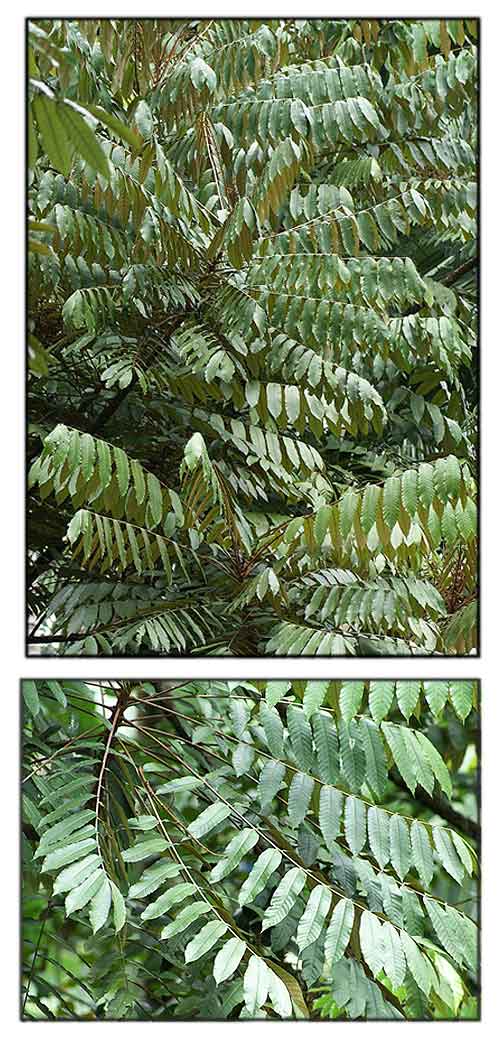 Gen info Gen info
- Aglaia is a genus of 121 recognized species of woody dioecious trees in the mahogany family Carmelia.
- Etymology: The genus name Aglaia is from a Greek word meaning splendor or beauty, or referring to one of the three Graces in Greek mythology.
Botany
• A medium-sized to large tree up to 43 m tall, bole branchless for up to 20 m, up to 90 cm in diameter, sometimes with buttresses up to 3 m high, bark surface brown, grayish-brown or greenish-gray, inner bark dark brown to pale yellowish-brown; leaflets 13-23, subopposite, with (15-)20-45 pairs of secondary veins, shiny and glabrous above and with numerous small pits, below densely covered with pale reddish-brown treeshaped hairs or with pale to dark brown stellate hairs or scales; flowers 5-merous, anthers 5, stylehead cylindrical, truncate at apex; fruit indéhiscent, 2(-4)-locular. (2)
Distribution
- Native to the Philippines.
- In primary and secondary forests, along rivers, on clay, sandstone, limestone at low to medium elevation, up to 1350 m.
- Also native to Borneo, Jawa, Laos, Malaya, Sulawesi, Sumatera, Thailand. (1)
- IUCN listed as Near Threatened (2021).
Constituents
- Study of n-hexane extract of Aglaia pachyphylla stem bark isolated three sesquiterpenoids, namely: β-caryophyllene oxide (1), 1β-Hydroxy-4(15),5-eudesmadiene (2), and spathulenol (3). (see study below) (3)
- Study
of ethanol extract of stem bark of A. pachyphylla isolated two novel pregnane steroids, pachylenone A (1) and pachylenone B (2), along with known steroids, 5α-dihydroprogesterone (3), GSD-8 (4), trans-5α-pregn-l7(20)-en-3,16-dion (5), 20β-hydroxy-5αH-pregnan-3-one (6), 3β-hydroxy-5α-pregnan-20-one (7), aglaiasterol B (8), and 2β,3β-dihydroxypregnan-16-one (9). (see study below) (4)
Properties
- Studies suggest anticancer properties.
Parts used
Stem bark.
Uses
Edibility
- No information found on edibility.
Folkloric
- No information on folkloric medicinal use.
Others
- Wood: Hard and durable and has a density of about 855 kg/m3 at 15% moisture content Used for making furniture, bridges, planks, secondary construction. (2)
Studies
• Cytotoxic Against MCF-7 Breast Cancer Cell Line / Sesquiterpenoids / Stem Bark: Study evaluated and characterized sesquiterpenoids from n-hexane extract of A. pachyphylla stem bark and determined its cytotoxicity against MCF-7 breast cancer cells. Three sesquiterpenoids were identified, namely: β-caryophyllene oxide (1), 1β-Hydroxy-4(15),5-eudesmadiene (2), and spathulenol (3). Tested against MCF-7 breast cancer cells, compound 2 showed highest cytotoxic activity with IC50 value of 262.25 µM. (3)
• Cytotoxic Pregnane Steroids Against MCF-7 Cancer Cell Line / Aglaiasterol B / Stem Bark: Pregnane steroids are secondary metabolites significantly involved in human biological systems. Over 500 unique pregnane steroids have been isolated from plants, with a diverse range of activities i.e. anti-inflammatory, antimicrobial, antiviral, anticancer. Study
of ethanol extract of stem bark of A. pachyphylla isolated two novel pregnane steroids, pachylenone A (1) and pachylenone B (2), along with seven known steroids. The cytotoxic effects of the steroid compounds (1-9) were examined against MCF-7 line. Compound 8, aglaiasterol B, showed strongest activity with IC50 of 228 µM, followed by compound 6 (!C50 568.76 µM) and compound 1, pachylenone A, with IC50 of 768.73 µM. (see constituents above) (4)
Availability
Wild-crafted. |

![]()




